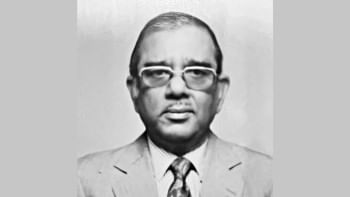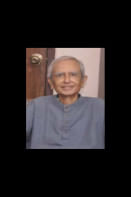Forever a restless civil servant

AM Anisuzzaman was certainly the most exciting person I worked with in the civil service. He also became, in later years, a dear, affectionate friend. He seemed to shine whenever handling a crisis. I used to tease him that though I'd had the good fortune of working with him on three assignments, each one had ended in disaster. He would only nod and smile gracefully.
Soon after joining the Civil Service of Pakistan in 1956, he took the unusual decision to build his professional career in agriculture. He served as managing director of Krishi Bank, secretary of the agriculture ministry, and then as chairman of Bangladesh Agricultural Development Corporation (BADC) in the 1970s and early 1980s. He initially served as deputy commissioner of Mymensingh during 1966-67, when I was stationed as a sub-divisional officer in Tangail. Both of us were unceremoniously thrown out when we both incurred the wrath of the then governor.
He was secretary at the Relief and Rehabilitation Department when I was seconded to assist him, along with AZM Nasiruddin who was deputy secretary in the same ministry. The deadly Bhola cyclone and tidal surge struck on the night of November 12, 1970, devastating the coastal belt and killing more than half-a-million people. The country and provincial administration failed to cope with the disaster and seemed to be on the verge of a meltdown. We discovered how restless the secretary had become, who was also appointed as the Relief Commissioner, to mount an urgent relief programme with whatever little resources he could mobilise.
On those days and late sleepless nights, I saw Anisuzzaman pacing from his office room, down the corridors, into the relief control centre—agitated, anxious, and desperate to get resources for urgent relief. The season's Aman rice crop had been destroyed. Winter had arrived. Millions were homeless. Hundreds of thousands of human and animal corpses, swollen and rotting, had filled up riverbanks. People were in immediate need of food, shelter, warm clothes, and medical care. Hundreds of thousands of new houses needed to be built—and the homeless had to be rehabilitated. Anisuzzaman was anxious and angry because there was little or no response from the all-powerful central government in faraway Islamabad. The immediate need was for strong logistical support—helicopters, speedboats, cargo launches—to reach the remote coastal regions and isolated char areas which had been devastated. He was sending out desperate SOS, fervent pleas for help, all around the world to anyone that mattered.
As aid from friendly countries and voluntary agencies belatedly started to trickle in, we witnessed one of the most massive emergency relief operations in history implemented under Anisuzzaman's leadership. I remember the crowded daily press conferences held in the ministry every evening, attended by dozens of media representatives and numerous foreign correspondents. Briefs used to be prepared by Nasir Bhai and myself. The secretary became quite agitated and even emotional in conveying to the press how inadequate were the efforts of the government and how urgent was the need for speeding up supplies.
As aid from friendly countries and voluntary agencies belatedly started to trickle in, we witnessed one of the most massive emergency relief operations in history implemented under Anisuzzaman's leadership. I remember the crowded daily press conferences held in the ministry every evening, attended by dozens of media representatives and numerous foreign correspondents. Briefs used to be prepared by Nasir Bhai and myself. The secretary became quite agitated and even emotional in conveying to the press how inadequate were the efforts of the government and how urgent was the need for speeding up supplies. Veteran journalists Ataus Samad and Mahbubul Alam had in their despatches reported on those tense outbursts and frustrations of a senior civil servant in charge of cyclone relief operations. The harrowing tale has now been documented in Jason Miklian and Scott Carney's book The Vortex: The True Story of History's Deadliest Storm and the Liberation of Bangladesh.
Another storm immediately followed the cyclone. Anisuzzaman's restlessness increased over time as our struggle for independence gained momentum after the elections. It became apparent from March 1, 1971, that in response to Bangabandhu's call, people were getting ready for a historic struggle for national liberation. What would the role of a tradition-bound civil service be in the freedom movement? The notion of neutrality or of sitting on the fence had become irrelevant for government servants.
At this crucial juncture, once again, Anisuzzaman provided much needed initiative and leadership. He convened a meeting of all Bangalee CSP officers at his residence on 39 Minto Road. Around 30 civil servants attending that meeting expressed their unequivocal allegiance to the cause of an independent Bangladesh. They decided to immediately make a financial contribution and, more importantly, send out forthwith representatives to meet deputy commissioners in outlying districts with instructions to extend their full support to the struggle. District administration helped mobilise the support of government officials and the local population for the impending resistance against the brutal military crackdown. Anisuzzaman, who had publicised the central government's apathy towards relief efforts after the cyclone, was already in the bad books of the Pakistani military regime. His initiative to mobilise Bangalee senior civil servants invited a quick retaliation from Islamabad. He was promptly relieved of his office as a secretary to the provincial government and was transferred to Sindh province in West Pakistan.
But Anisuzzaman's loyalty to newly-independent Bangladesh was so strong that instead of waiting for repatriation, he decided to escape Pakistan with his family early in 1972 via a snowy, difficult mountain pass in Balochistan. Very soon, he joined the Ministry of Agriculture in the new government and committed himself heart-and-soul for the development of the agricultural sector of a war-torn country.
It was once again an arduous journey for an earnest, restless civil servant. He was appointed as secretary of the government, then as chairman of Bangladesh Agricultural Development Corporation, and finally had a long stint as special advisor for agriculture to Prime Minister Sheikh Hasina for five years in late 90s. It was under his dynamic watch that Bangladeshi agriculture witnessed a magnificent transformation from being "a basket case" to having a self-sufficient and vibrant agricultural economy. Of course, this happened primarily because of enterprising peasants and farmers who quickly adopted new irrigation-based technologies along with fertiliser responsive high-yield crop varieties. Production of fish and livestock also increased dramatically.
During his long tenure, Anisuzzaman dedicated himself to promoting the development of agriculture. It was no doubt a very complex, multifaceted task. He committed himself passionately, full-time, and worked round the clock, without any rest. He was an excellent field officer who ceaselessly toured up and down the country, always being directly in touch with farmers and the field staff.
AM Anisuzzaman believed that, for development of agriculture to happen in Bangladesh, initiatives must come from specialists of numerous related disciplines. He succeeded in building syncretic relationships with the most renowned agricultural specialists, economists, planners, bureaucrats, and politicians—people coming from various backgrounds. It was an active and growing network comprising the most reputed researchers and extension workers in the field. He was able to plan, coordinate, and weave into the mainstream specialists from numerous disciplines, and motivated them to work together by formulating strategies, building institutions, and implementing specific projects. I have seen him spending long hours discussing and debating options in his office as well as at his home.
He built close personal relationships with reputed scientist (and subsequent chairman of the Agricultural Research Council) Dr Badruddoza, horticulturist Dr Ishaq, marketing expert Maziruddin, leading rice researcher Dr Hasanuzzaman, agricultural economist Dr Raisuddin, and many others. At the political level, he was quite close to Motia Chowdhury and Tofail Ahmed. He spent days touring the countryside with Hugh Brammer, who knew more about Bangladeshi soils than anyone else. Anisuzzaman energised institutions like the Bangladesh Rice Research Institute, Bangladesh Agricultural Research Institute, Krishi Bank and other financing institutions, the Planning Commission, agriculture ministry, agricultural extension directorate, external aid agencies, non-government organisations, and finally the BADC. He was directly involved in making policies, formulating plans, and setting goals, and in organising teams to achieve them while supervising and coordinating implementation. Without a formal mandate, he was, for almost two decades, the CEO of the country's agricultural development programme.
Although much appreciated by his colleagues and friends, he did not receive any accolades or awards. But that's how it should be for a professional civil servant. AM Anisuzzaman died incognito, peacefully in his sleep on November 29, 2023. I pray fervently along with his friends and many well-wishers that the ever restless civil servant will finally rest in peace.
Khalid Shams is a former civil servant.

 For all latest news, follow The Daily Star's Google News channel.
For all latest news, follow The Daily Star's Google News channel. 








Comments